Your taste, your town
 Photobac/Shutterstock
Photobac/ShutterstockJust as
your favorite ice cream flavor can reveal hidden personality traits, your favorite foods can reveal where you're from. Seriously. Repeat childhood exposure to any food tends to
promote a preference for that food that can last a lifetime. That means the foods you enjoyed with your family and friends during childhood are more likely to be at the top your list today—or even your go-to
comfort food. And that's why we're willing to bet we can guess where you're from...if you call any of these foods your favorites.
Sloppy Joe
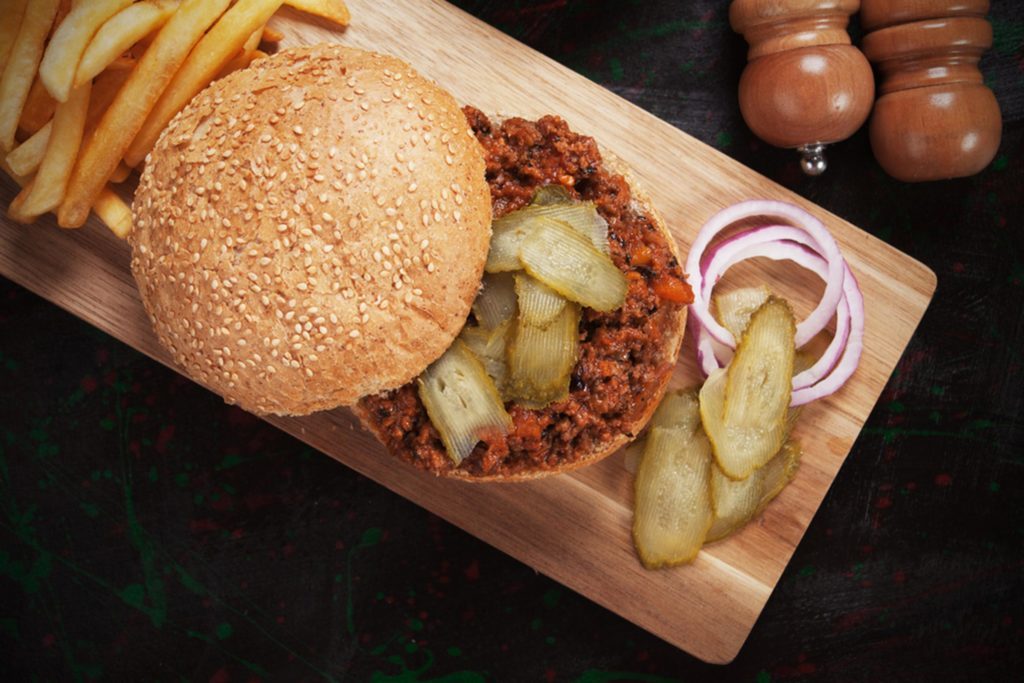 IgorDutina/Shutterstock
IgorDutina/ShutterstockWe're not talking about the sandwich made with ground beef and tomato sauce. We're talking about the
double-decker deli sandwich served on three slices of super-thin rye bread and made up of two super-thin-sliced deli meats (my own favorite from my childhood in New Jersey is turkey and beef tongue), plus Swiss cheese, coleslaw, and Russian dressing. It was invented in New Jersey, and if you grew up in New Jersey, it's the
only acceptable Sloppy Joe, and you can spend literally hours arguing with other Jersey natives about which deli makes the best, and which deli made it first.
Verdict: If your idea of a Sloppy Joe can
only involve deli meats, coleslaw, and thin-sliced rye, and if you call it a "regular Joe" or a "Jersey Joe" to distinguish it from the stuff your out-of-state friends make with Manwich, then you're probably from New Jersey.
Looking for a more healthy sandwich alternative? Try these
healthy sandwich recipes at home.
Rocky Mountain Oysters
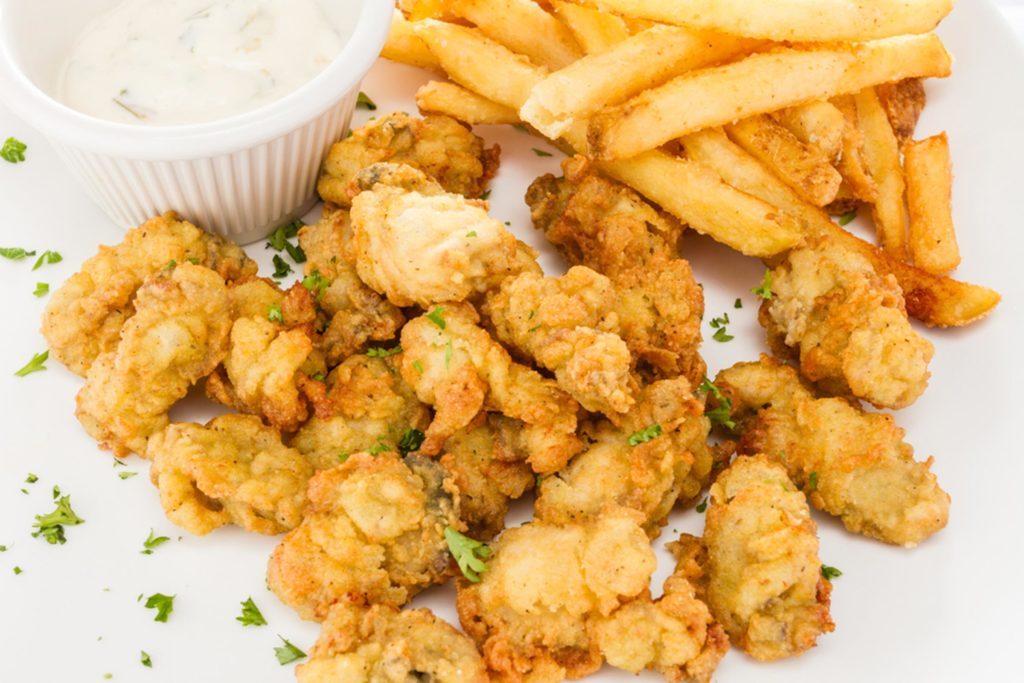 DawnaMoore/Shutterstock
DawnaMoore/ShutterstockTo be absolutely clear, they're not seafood, and the people who love them most likely grew up land-locked. What we're talking about when we talk about
Rocky Mountain Oysters are the testicles of a bull—or sometimes a pig or a sheep. Peeled, cut into bite-size pieces (or not), and deep-fried, Rocky Mountain Oysters are "cowboy food," and can be found wherever cattle-ranching is prevalent.
Although Eagle, Idaho, claims to have the "World's Largest Rocky Mountain Oyster Feed" during its Eagle Fun Days, a festival held during the second weekend of July, you'll find "testical festivals" in Montana, Michigan, Illinois, Missouri, Colorado, and Ohio. And even if you can't make it to a festival,
many restaurants and bars in Montana, Idaho, Kansas, and Wyoming serve Rocky Mountain oysters all year long.
Verdict: If you wax poetic over this tender, fried delicacy, you're most likely from one of the aforementioned states. If you call them "tendergroins," you're probably from Montana, in which case you've probably partaken of this local delicacy while spending a summer day at the
Montana State Fair.
Fried cheese curds
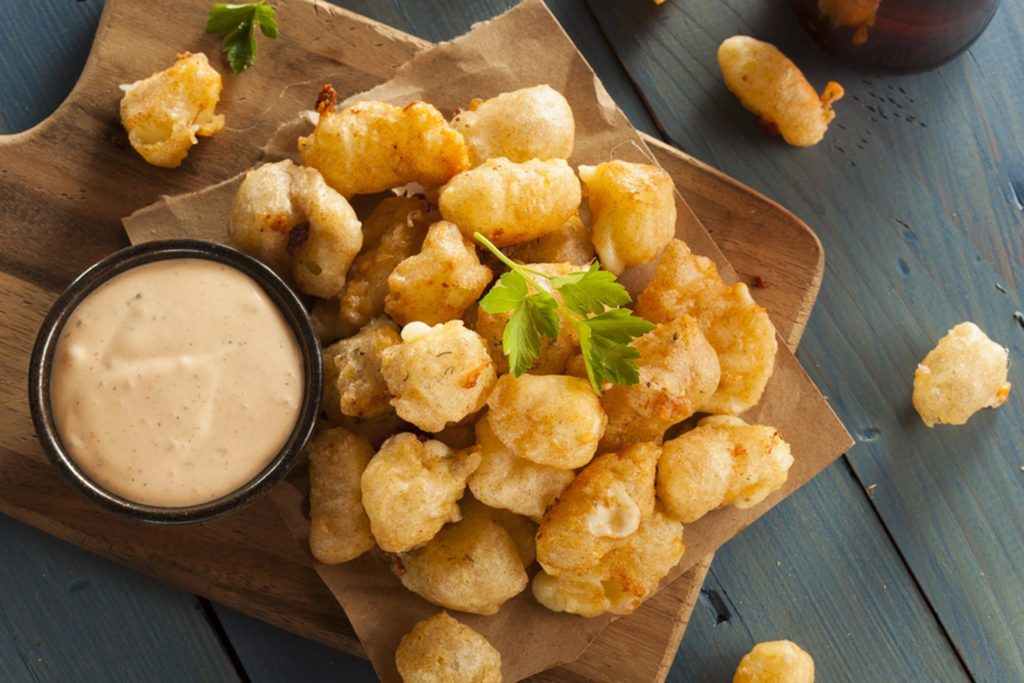 BrentHofacker/Shutterstock
BrentHofacker/ShutterstockCheese curds are an essential product of the cheese-making process, according to
Eat Curds, the website devoted to all things cheese curd. Before cheeses like cheddar are formed into blocks or wheels and aged, they start out as curds. Fresh cheese curds have a slightly rubbery texture and squeak when you eat them, and are best eaten the same day they're produced.
Cheese curds are an important part of
poutine, which is the unofficial national comfort-food of Canada but is also enjoyed all over the United States. They're available wherever dairy production is in high gear. But "there's nothing more Wisconsin than a cheese curd," according to Eat Curds, which displays a vast number of places where you can find them fresh in Wisconsin.
Verdict: If you like cheese curds apart from your poutine, and if you like them fresh out of the cheese-making vat—and if you understand why it's important that they're squeaky when you eat them, we're going to have to guess you're from Wisconsin, which is, after all, "
America's Dairyland."
Clam chowder
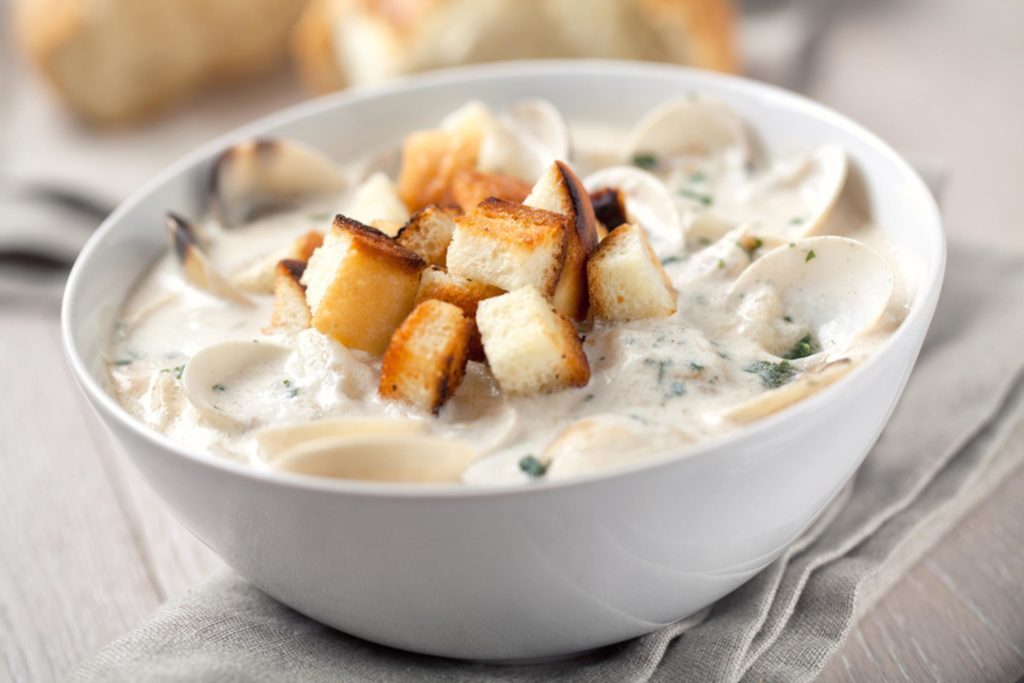 svalophoto/shutterstock
svalophoto/shutterstockIf you read "
clam chowder" and wonder which version we're referring to, then you're not from New England. In New England, there's only one kind of clam chowder, and it's cream-based and includes potatoes and onions. In 1939, a bill was introduced into legislature in the state of Maine that would make the use of tomatoes in clam chowder illegal.
Verdict: If you wouldn't even
think of eating a "clam chowder" that involves anything resembling tomatoes, then you're probably from New England. And no matter where you're from, when in New England, be sure to give traditional "clam chowder" a try. Just try not to think about the calories. If you're watching your waistline,
these are the soups to eat instead.
Lobster with drawn butter
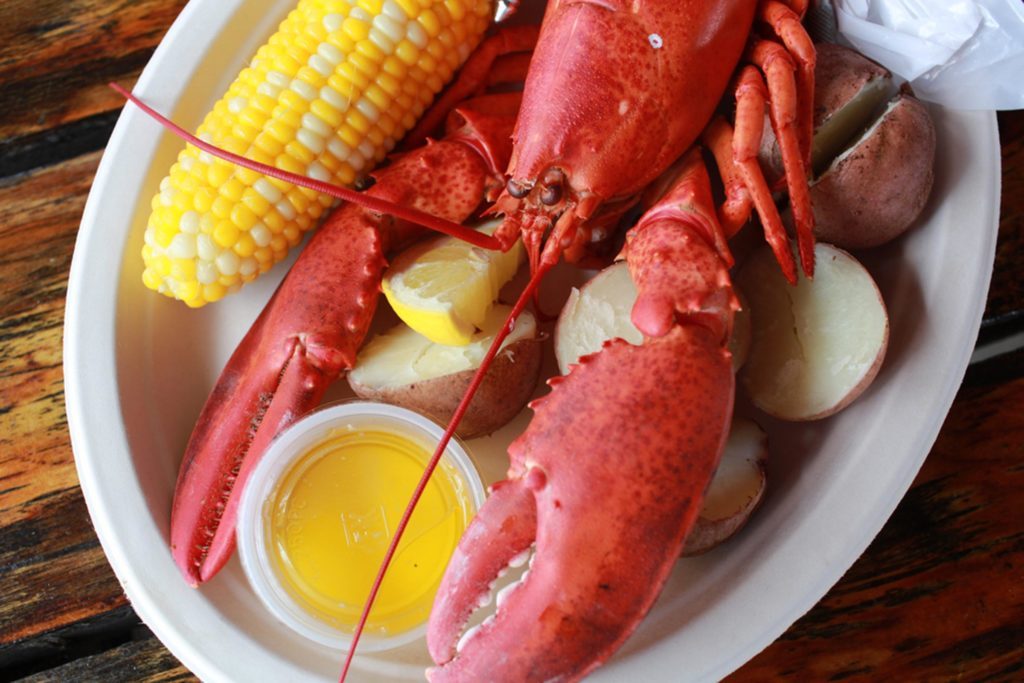 Alexandralaw1977/Shutterstock
Alexandralaw1977/ShutterstockSure, lobster can be found virtually anywhere, even in places so far from the ocean that the smell of sea-water is purely hypothetical. But there's only one place where the lobsters are so fresh, so tender, and so mind-bogglingly sweet that they should, and generally are, prepared only by steaming (or boiling) in seawater (or saltwater) and served whole, with nutcrackers, a slender pick, and only a small cup of melted, unsalted butter for added flavor. And that's
Maine, where lobstering has been an industry since the year 1600 and which is home to 5,600 independent lobstermen.
And there's a special reason why lobster from Maine is so special: From mid-June to November, lobsters in the cold, clean waters of Maine shed their shells and reveal new, larger ones underneath—the result: Maine New Shell Lobster. As the lobsters grow into their newly formed shell, there is a gap between the meat and the shell that seawater fills, allowing it to naturally marinate the meat, resulting in what many (especially natives of Maine) will agree is the sweetest, most tender, most "lobster-y lobster" on the planet.
Verdict: If you probably wouldn't eat lobster that doesn't come from Maine, or if you'd go so far as to admit that you wouldn't eat lobster outside of Maine's state lines, then you're probably from Maine. If it doesn't bother you that you've made a meal out of an animal that might have otherwise lived to be 140 years old, then you're definitely from Maine!
Chipati™
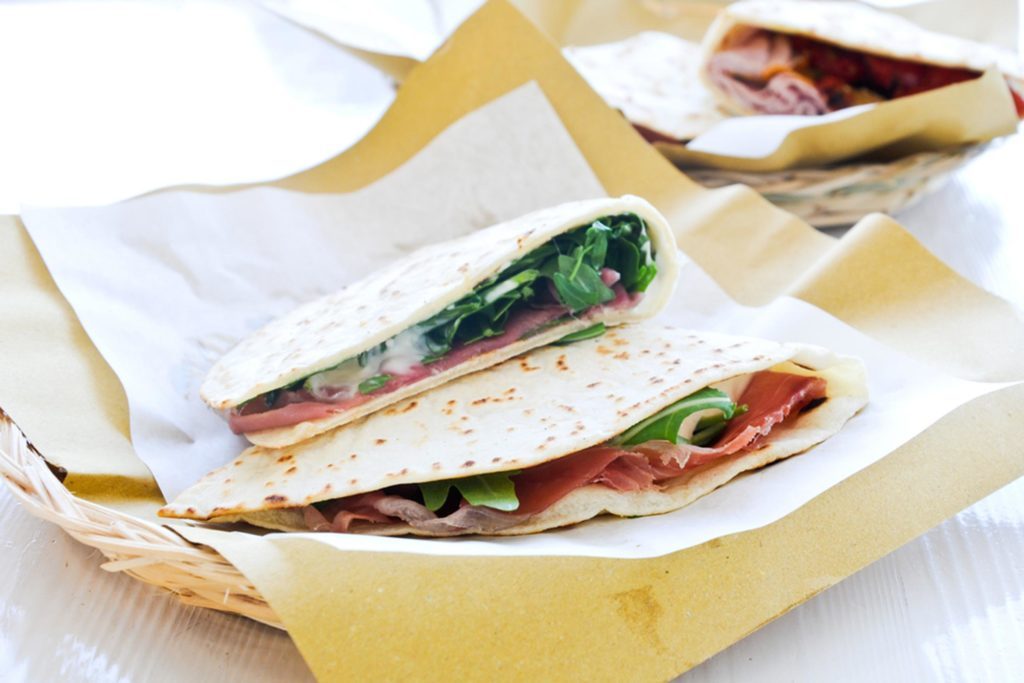 giovanni boscherino/Shutterstock
giovanni boscherino/ShutterstockIt's not the Indian bread, which is spelled "chapati." A
Chipati is a type of sandwich. It's actually been trademarked, and if you know what it is or if you still dream about it well into adulthood, then either you grew up in the Ann Arbor, Michigan area, or you went to school at the University of Michigan. The chipati was invented in the 1970s at Pizza Bob's on State Street in Ann Arbor. It's made with wheat-flour-based "Chipati bread" that somewhat resembles pita bread that's stuffed with lettuce, tomatoes, green peppers, sweet red peppers, mushrooms, cheese, and "Chipati sauce," which might be described as oregano-flecked French dressing.
Verdict: If you even know what a chipati is, let alone feel it's the best sandwich you've ever tasted, then you're definitely from Ann Arbor, or you spent your college years there.
Did you know that the University of Michigan is the most selective college in Michigan? This
infographic shows the hardest colleges to get into in each of the 50 states.
Lutefisk
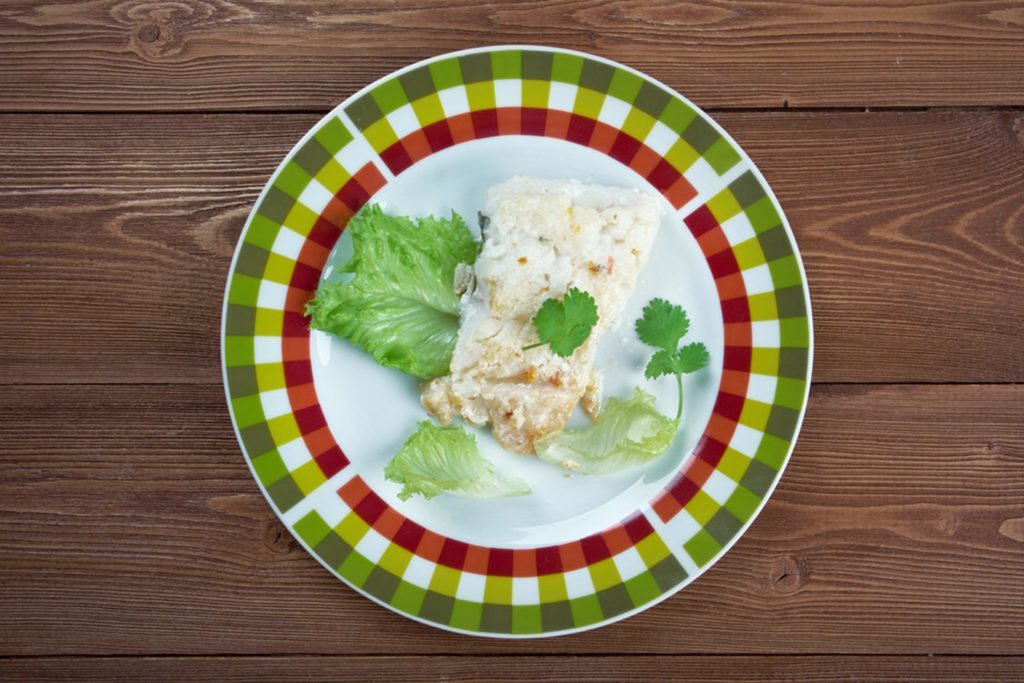 Fanfo/shutterstock
Fanfo/shutterstockIf you watched the series,
Fortitude, which is currently streaming on Amazon, then you know that
Lutefisk is codfish that's been salted and soaked in lye for two days (until its pH reaches 12, which is caustic enough for a chemical burn) and then soaked in water for another six days, upon which it's steamed for 25 minutes and served in all its stinky, gelatinous glory.
If you watched
Fortitude, you also know that "the truth about lutefisk is you should never eat lutefisk." But try telling that to Norway and Sweden, where the dish originated. And try telling that to Madison, Minnesota, which has dubbed itself the "lutefisk capital of the world." But lutefisk is really a thing all over the state of Minnesota, where "
lutefisk dinners" are annual traditions at scores of Lutheran churches and Nordic fraternal groups. That said, the Swedish-Americans tend to prepare their lutefish with allspice seasoning, while the Norwegian-Americans tend to prefer it unseasoned.
Verdict: Although lutefisk is served wherever you'll find large numbers of Scandinavian-Americans, if you've got an opinion on how it should be prepared, then you're probably from Minnesota, which, by the way, is the setting for the iconic Sinclair Lewis book,
Main Street. Find out
the most iconic book set in each of the 50 states.
King cake
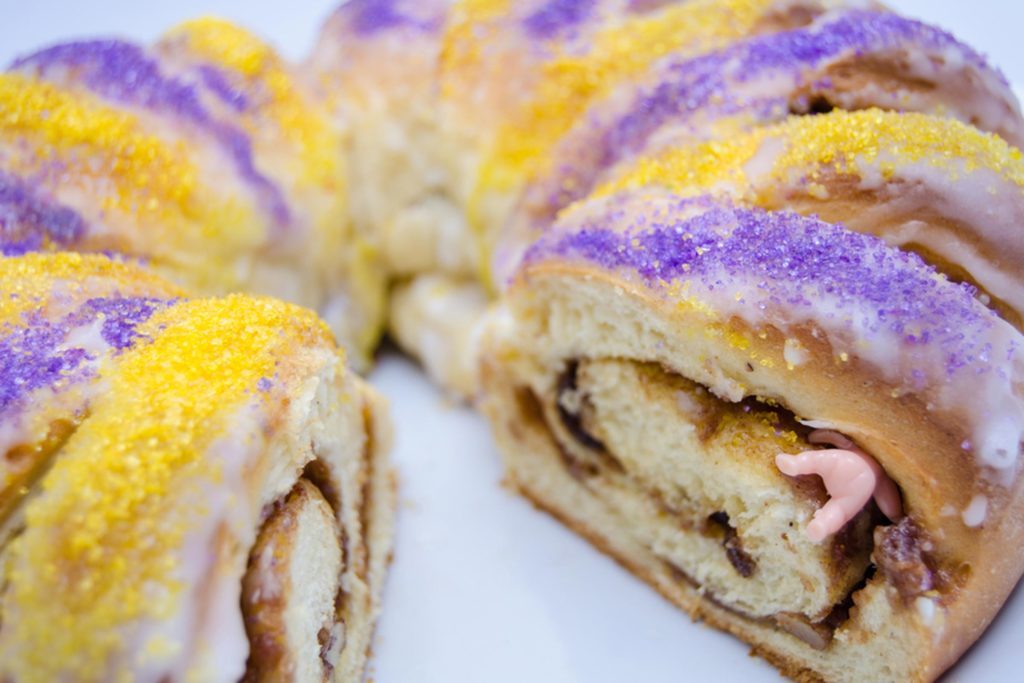 DellriumTrigger/Shutterstock
DellriumTrigger/ShutterstockThis mildly sweet ring of cake-y bread dough that's been twisted into a ring and decorated with brightly colored icing and sprinkles is synonymous with the celebration of Mardi Gras in New Orleans, where
king cakes can be found starting in early January and all the way up until Ash Wednesday and the start of Lent. Typically, a tiny plastic baby trinket (or a representative bean) is baked into the cake, and whoever finds it has to host the next year's celebration. They may also get to be "king" for the day.
King cake had its origins in Europe and came to be associated with the Catholic celebration of Epiphany (on January 6) in the Middle Ages. French versions tend to be made with flaky pastry. The version served in Louisiana, and specifically, New Orleans, is more like that which originated in Spain.
Verdict: If your idea of king cake involves a cake-bread dough that's decorated in the colors associated with Mardi Gras (green, gold, and purple), then you're probably from Louisiana, and quite possibly from New Orleans.
No matter where you're from, it's pretty likely that you don't really know how to slice a cake. Learn what
science has to teach us about cutting a cake.
Reindeer stew
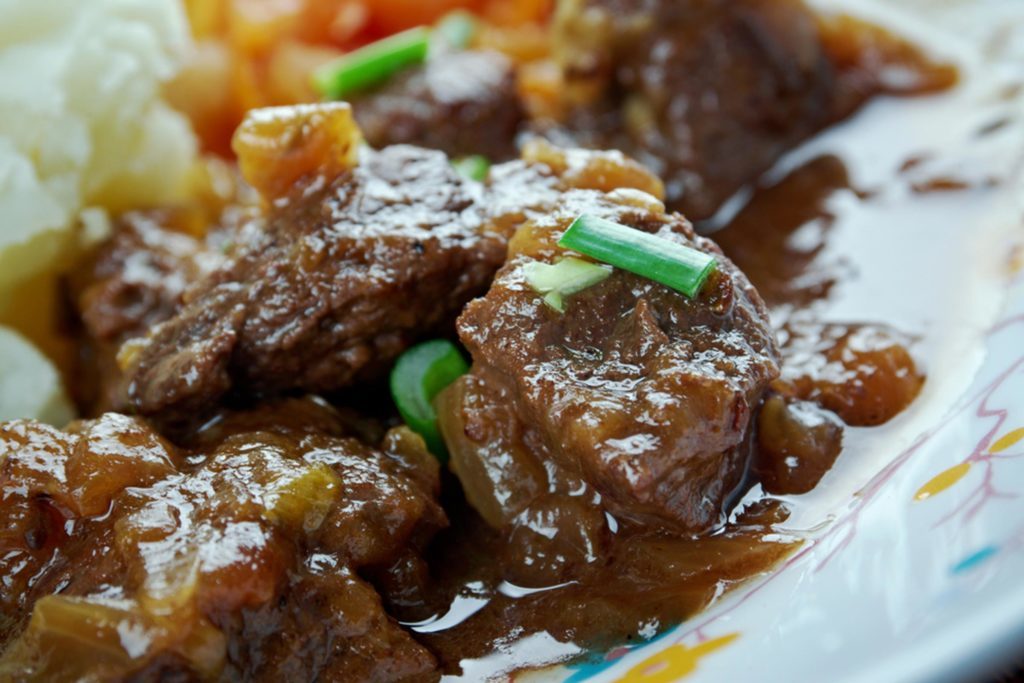 Fanfo/Shutterstock
Fanfo/ShutterstockActually, it doesn't even have to be stew. It could also be reindeer dogs, as in hot dogs made with reindeer meat. For that matter, just about anything you can make with meat not only tastes better, but is way healthier, when made with
reindeer, according to its fans.
Apparently, these 350-pound animals store fat outside their muscles, which means there's no marbling—just incredibly lean meat. Reindeer meat is also a rich source of omega-3 and essential fatty acids, so much so that it's comparable to fish,
according to scientists at the University of Norway. True connoisseurs like to eat it raw, and it's safe to do so, at least in Alaska because it's herded cleanly and safely on Alaska's tundra, specifically on St. Lawrence, Unimak, and Umnak Islands.
Verdict: If you when you think of reindeer, you're thinking of a delicious dish that is best served raw, rather than as the beasts that lead Santa's sleigh on Christmas, then you're probably from Alaska. If you don't mind eating reindeer despite that
some people keep reindeer as pets, you're almost definitely from Alaska.
 Just as your favorite ice cream flavor can reveal hidden personality traits, your favorite foods can reveal where you're from. Seriously. Repeat childhood exposure to any food tends to promote a preference for that food that can last a lifetime. That means the foods you enjoyed with your family and friends during childhood are more likely to be at the top your list today—or even your go-to comfort food. And that's why we're willing to bet we can guess where you're from...if you call any of these foods your favorites.
Just as your favorite ice cream flavor can reveal hidden personality traits, your favorite foods can reveal where you're from. Seriously. Repeat childhood exposure to any food tends to promote a preference for that food that can last a lifetime. That means the foods you enjoyed with your family and friends during childhood are more likely to be at the top your list today—or even your go-to comfort food. And that's why we're willing to bet we can guess where you're from...if you call any of these foods your favorites. We're not talking about the sandwich made with ground beef and tomato sauce. We're talking about the double-decker deli sandwich served on three slices of super-thin rye bread and made up of two super-thin-sliced deli meats (my own favorite from my childhood in New Jersey is turkey and beef tongue), plus Swiss cheese, coleslaw, and Russian dressing. It was invented in New Jersey, and if you grew up in New Jersey, it's the only acceptable Sloppy Joe, and you can spend literally hours arguing with other Jersey natives about which deli makes the best, and which deli made it first.
Verdict: If your idea of a Sloppy Joe can only involve deli meats, coleslaw, and thin-sliced rye, and if you call it a "regular Joe" or a "Jersey Joe" to distinguish it from the stuff your out-of-state friends make with Manwich, then you're probably from New Jersey.
Looking for a more healthy sandwich alternative? Try these healthy sandwich recipes at home.
We're not talking about the sandwich made with ground beef and tomato sauce. We're talking about the double-decker deli sandwich served on three slices of super-thin rye bread and made up of two super-thin-sliced deli meats (my own favorite from my childhood in New Jersey is turkey and beef tongue), plus Swiss cheese, coleslaw, and Russian dressing. It was invented in New Jersey, and if you grew up in New Jersey, it's the only acceptable Sloppy Joe, and you can spend literally hours arguing with other Jersey natives about which deli makes the best, and which deli made it first.
Verdict: If your idea of a Sloppy Joe can only involve deli meats, coleslaw, and thin-sliced rye, and if you call it a "regular Joe" or a "Jersey Joe" to distinguish it from the stuff your out-of-state friends make with Manwich, then you're probably from New Jersey.
Looking for a more healthy sandwich alternative? Try these healthy sandwich recipes at home.
 To be absolutely clear, they're not seafood, and the people who love them most likely grew up land-locked. What we're talking about when we talk about Rocky Mountain Oysters are the testicles of a bull—or sometimes a pig or a sheep. Peeled, cut into bite-size pieces (or not), and deep-fried, Rocky Mountain Oysters are "cowboy food," and can be found wherever cattle-ranching is prevalent.
Although Eagle, Idaho, claims to have the "World's Largest Rocky Mountain Oyster Feed" during its Eagle Fun Days, a festival held during the second weekend of July, you'll find "testical festivals" in Montana, Michigan, Illinois, Missouri, Colorado, and Ohio. And even if you can't make it to a festival, many restaurants and bars in Montana, Idaho, Kansas, and Wyoming serve Rocky Mountain oysters all year long.
Verdict: If you wax poetic over this tender, fried delicacy, you're most likely from one of the aforementioned states. If you call them "tendergroins," you're probably from Montana, in which case you've probably partaken of this local delicacy while spending a summer day at the Montana State Fair.
To be absolutely clear, they're not seafood, and the people who love them most likely grew up land-locked. What we're talking about when we talk about Rocky Mountain Oysters are the testicles of a bull—or sometimes a pig or a sheep. Peeled, cut into bite-size pieces (or not), and deep-fried, Rocky Mountain Oysters are "cowboy food," and can be found wherever cattle-ranching is prevalent.
Although Eagle, Idaho, claims to have the "World's Largest Rocky Mountain Oyster Feed" during its Eagle Fun Days, a festival held during the second weekend of July, you'll find "testical festivals" in Montana, Michigan, Illinois, Missouri, Colorado, and Ohio. And even if you can't make it to a festival, many restaurants and bars in Montana, Idaho, Kansas, and Wyoming serve Rocky Mountain oysters all year long.
Verdict: If you wax poetic over this tender, fried delicacy, you're most likely from one of the aforementioned states. If you call them "tendergroins," you're probably from Montana, in which case you've probably partaken of this local delicacy while spending a summer day at the Montana State Fair.
 Cheese curds are an essential product of the cheese-making process, according to Eat Curds, the website devoted to all things cheese curd. Before cheeses like cheddar are formed into blocks or wheels and aged, they start out as curds. Fresh cheese curds have a slightly rubbery texture and squeak when you eat them, and are best eaten the same day they're produced.
Cheese curds are an important part of poutine, which is the unofficial national comfort-food of Canada but is also enjoyed all over the United States. They're available wherever dairy production is in high gear. But "there's nothing more Wisconsin than a cheese curd," according to Eat Curds, which displays a vast number of places where you can find them fresh in Wisconsin.
Verdict: If you like cheese curds apart from your poutine, and if you like them fresh out of the cheese-making vat—and if you understand why it's important that they're squeaky when you eat them, we're going to have to guess you're from Wisconsin, which is, after all, "America's Dairyland."
Cheese curds are an essential product of the cheese-making process, according to Eat Curds, the website devoted to all things cheese curd. Before cheeses like cheddar are formed into blocks or wheels and aged, they start out as curds. Fresh cheese curds have a slightly rubbery texture and squeak when you eat them, and are best eaten the same day they're produced.
Cheese curds are an important part of poutine, which is the unofficial national comfort-food of Canada but is also enjoyed all over the United States. They're available wherever dairy production is in high gear. But "there's nothing more Wisconsin than a cheese curd," according to Eat Curds, which displays a vast number of places where you can find them fresh in Wisconsin.
Verdict: If you like cheese curds apart from your poutine, and if you like them fresh out of the cheese-making vat—and if you understand why it's important that they're squeaky when you eat them, we're going to have to guess you're from Wisconsin, which is, after all, "America's Dairyland."
 If you read "clam chowder" and wonder which version we're referring to, then you're not from New England. In New England, there's only one kind of clam chowder, and it's cream-based and includes potatoes and onions. In 1939, a bill was introduced into legislature in the state of Maine that would make the use of tomatoes in clam chowder illegal.
Verdict: If you wouldn't even think of eating a "clam chowder" that involves anything resembling tomatoes, then you're probably from New England. And no matter where you're from, when in New England, be sure to give traditional "clam chowder" a try. Just try not to think about the calories. If you're watching your waistline, these are the soups to eat instead.
If you read "clam chowder" and wonder which version we're referring to, then you're not from New England. In New England, there's only one kind of clam chowder, and it's cream-based and includes potatoes and onions. In 1939, a bill was introduced into legislature in the state of Maine that would make the use of tomatoes in clam chowder illegal.
Verdict: If you wouldn't even think of eating a "clam chowder" that involves anything resembling tomatoes, then you're probably from New England. And no matter where you're from, when in New England, be sure to give traditional "clam chowder" a try. Just try not to think about the calories. If you're watching your waistline, these are the soups to eat instead.
 Sure, lobster can be found virtually anywhere, even in places so far from the ocean that the smell of sea-water is purely hypothetical. But there's only one place where the lobsters are so fresh, so tender, and so mind-bogglingly sweet that they should, and generally are, prepared only by steaming (or boiling) in seawater (or saltwater) and served whole, with nutcrackers, a slender pick, and only a small cup of melted, unsalted butter for added flavor. And that's Maine, where lobstering has been an industry since the year 1600 and which is home to 5,600 independent lobstermen.
And there's a special reason why lobster from Maine is so special: From mid-June to November, lobsters in the cold, clean waters of Maine shed their shells and reveal new, larger ones underneath—the result: Maine New Shell Lobster. As the lobsters grow into their newly formed shell, there is a gap between the meat and the shell that seawater fills, allowing it to naturally marinate the meat, resulting in what many (especially natives of Maine) will agree is the sweetest, most tender, most "lobster-y lobster" on the planet.
Verdict: If you probably wouldn't eat lobster that doesn't come from Maine, or if you'd go so far as to admit that you wouldn't eat lobster outside of Maine's state lines, then you're probably from Maine. If it doesn't bother you that you've made a meal out of an animal that might have otherwise lived to be 140 years old, then you're definitely from Maine!
Sure, lobster can be found virtually anywhere, even in places so far from the ocean that the smell of sea-water is purely hypothetical. But there's only one place where the lobsters are so fresh, so tender, and so mind-bogglingly sweet that they should, and generally are, prepared only by steaming (or boiling) in seawater (or saltwater) and served whole, with nutcrackers, a slender pick, and only a small cup of melted, unsalted butter for added flavor. And that's Maine, where lobstering has been an industry since the year 1600 and which is home to 5,600 independent lobstermen.
And there's a special reason why lobster from Maine is so special: From mid-June to November, lobsters in the cold, clean waters of Maine shed their shells and reveal new, larger ones underneath—the result: Maine New Shell Lobster. As the lobsters grow into their newly formed shell, there is a gap between the meat and the shell that seawater fills, allowing it to naturally marinate the meat, resulting in what many (especially natives of Maine) will agree is the sweetest, most tender, most "lobster-y lobster" on the planet.
Verdict: If you probably wouldn't eat lobster that doesn't come from Maine, or if you'd go so far as to admit that you wouldn't eat lobster outside of Maine's state lines, then you're probably from Maine. If it doesn't bother you that you've made a meal out of an animal that might have otherwise lived to be 140 years old, then you're definitely from Maine!
 It's not the Indian bread, which is spelled "chapati." A Chipati is a type of sandwich. It's actually been trademarked, and if you know what it is or if you still dream about it well into adulthood, then either you grew up in the Ann Arbor, Michigan area, or you went to school at the University of Michigan. The chipati was invented in the 1970s at Pizza Bob's on State Street in Ann Arbor. It's made with wheat-flour-based "Chipati bread" that somewhat resembles pita bread that's stuffed with lettuce, tomatoes, green peppers, sweet red peppers, mushrooms, cheese, and "Chipati sauce," which might be described as oregano-flecked French dressing.
Verdict: If you even know what a chipati is, let alone feel it's the best sandwich you've ever tasted, then you're definitely from Ann Arbor, or you spent your college years there.
Did you know that the University of Michigan is the most selective college in Michigan? This infographic shows the hardest colleges to get into in each of the 50 states.
It's not the Indian bread, which is spelled "chapati." A Chipati is a type of sandwich. It's actually been trademarked, and if you know what it is or if you still dream about it well into adulthood, then either you grew up in the Ann Arbor, Michigan area, or you went to school at the University of Michigan. The chipati was invented in the 1970s at Pizza Bob's on State Street in Ann Arbor. It's made with wheat-flour-based "Chipati bread" that somewhat resembles pita bread that's stuffed with lettuce, tomatoes, green peppers, sweet red peppers, mushrooms, cheese, and "Chipati sauce," which might be described as oregano-flecked French dressing.
Verdict: If you even know what a chipati is, let alone feel it's the best sandwich you've ever tasted, then you're definitely from Ann Arbor, or you spent your college years there.
Did you know that the University of Michigan is the most selective college in Michigan? This infographic shows the hardest colleges to get into in each of the 50 states.
 If you watched the series, Fortitude, which is currently streaming on Amazon, then you know that Lutefisk is codfish that's been salted and soaked in lye for two days (until its pH reaches 12, which is caustic enough for a chemical burn) and then soaked in water for another six days, upon which it's steamed for 25 minutes and served in all its stinky, gelatinous glory.
If you watched Fortitude, you also know that "the truth about lutefisk is you should never eat lutefisk." But try telling that to Norway and Sweden, where the dish originated. And try telling that to Madison, Minnesota, which has dubbed itself the "lutefisk capital of the world." But lutefisk is really a thing all over the state of Minnesota, where "lutefisk dinners" are annual traditions at scores of Lutheran churches and Nordic fraternal groups. That said, the Swedish-Americans tend to prepare their lutefish with allspice seasoning, while the Norwegian-Americans tend to prefer it unseasoned.
Verdict: Although lutefisk is served wherever you'll find large numbers of Scandinavian-Americans, if you've got an opinion on how it should be prepared, then you're probably from Minnesota, which, by the way, is the setting for the iconic Sinclair Lewis book, Main Street. Find out the most iconic book set in each of the 50 states.
If you watched the series, Fortitude, which is currently streaming on Amazon, then you know that Lutefisk is codfish that's been salted and soaked in lye for two days (until its pH reaches 12, which is caustic enough for a chemical burn) and then soaked in water for another six days, upon which it's steamed for 25 minutes and served in all its stinky, gelatinous glory.
If you watched Fortitude, you also know that "the truth about lutefisk is you should never eat lutefisk." But try telling that to Norway and Sweden, where the dish originated. And try telling that to Madison, Minnesota, which has dubbed itself the "lutefisk capital of the world." But lutefisk is really a thing all over the state of Minnesota, where "lutefisk dinners" are annual traditions at scores of Lutheran churches and Nordic fraternal groups. That said, the Swedish-Americans tend to prepare their lutefish with allspice seasoning, while the Norwegian-Americans tend to prefer it unseasoned.
Verdict: Although lutefisk is served wherever you'll find large numbers of Scandinavian-Americans, if you've got an opinion on how it should be prepared, then you're probably from Minnesota, which, by the way, is the setting for the iconic Sinclair Lewis book, Main Street. Find out the most iconic book set in each of the 50 states.
 This mildly sweet ring of cake-y bread dough that's been twisted into a ring and decorated with brightly colored icing and sprinkles is synonymous with the celebration of Mardi Gras in New Orleans, where king cakes can be found starting in early January and all the way up until Ash Wednesday and the start of Lent. Typically, a tiny plastic baby trinket (or a representative bean) is baked into the cake, and whoever finds it has to host the next year's celebration. They may also get to be "king" for the day.
King cake had its origins in Europe and came to be associated with the Catholic celebration of Epiphany (on January 6) in the Middle Ages. French versions tend to be made with flaky pastry. The version served in Louisiana, and specifically, New Orleans, is more like that which originated in Spain.
Verdict: If your idea of king cake involves a cake-bread dough that's decorated in the colors associated with Mardi Gras (green, gold, and purple), then you're probably from Louisiana, and quite possibly from New Orleans.
No matter where you're from, it's pretty likely that you don't really know how to slice a cake. Learn what science has to teach us about cutting a cake.
This mildly sweet ring of cake-y bread dough that's been twisted into a ring and decorated with brightly colored icing and sprinkles is synonymous with the celebration of Mardi Gras in New Orleans, where king cakes can be found starting in early January and all the way up until Ash Wednesday and the start of Lent. Typically, a tiny plastic baby trinket (or a representative bean) is baked into the cake, and whoever finds it has to host the next year's celebration. They may also get to be "king" for the day.
King cake had its origins in Europe and came to be associated with the Catholic celebration of Epiphany (on January 6) in the Middle Ages. French versions tend to be made with flaky pastry. The version served in Louisiana, and specifically, New Orleans, is more like that which originated in Spain.
Verdict: If your idea of king cake involves a cake-bread dough that's decorated in the colors associated with Mardi Gras (green, gold, and purple), then you're probably from Louisiana, and quite possibly from New Orleans.
No matter where you're from, it's pretty likely that you don't really know how to slice a cake. Learn what science has to teach us about cutting a cake.
 Actually, it doesn't even have to be stew. It could also be reindeer dogs, as in hot dogs made with reindeer meat. For that matter, just about anything you can make with meat not only tastes better, but is way healthier, when made with reindeer, according to its fans.
Apparently, these 350-pound animals store fat outside their muscles, which means there's no marbling—just incredibly lean meat. Reindeer meat is also a rich source of omega-3 and essential fatty acids, so much so that it's comparable to fish, according to scientists at the University of Norway. True connoisseurs like to eat it raw, and it's safe to do so, at least in Alaska because it's herded cleanly and safely on Alaska's tundra, specifically on St. Lawrence, Unimak, and Umnak Islands.
Verdict: If you when you think of reindeer, you're thinking of a delicious dish that is best served raw, rather than as the beasts that lead Santa's sleigh on Christmas, then you're probably from Alaska. If you don't mind eating reindeer despite that some people keep reindeer as pets, you're almost definitely from Alaska.
Actually, it doesn't even have to be stew. It could also be reindeer dogs, as in hot dogs made with reindeer meat. For that matter, just about anything you can make with meat not only tastes better, but is way healthier, when made with reindeer, according to its fans.
Apparently, these 350-pound animals store fat outside their muscles, which means there's no marbling—just incredibly lean meat. Reindeer meat is also a rich source of omega-3 and essential fatty acids, so much so that it's comparable to fish, according to scientists at the University of Norway. True connoisseurs like to eat it raw, and it's safe to do so, at least in Alaska because it's herded cleanly and safely on Alaska's tundra, specifically on St. Lawrence, Unimak, and Umnak Islands.
Verdict: If you when you think of reindeer, you're thinking of a delicious dish that is best served raw, rather than as the beasts that lead Santa's sleigh on Christmas, then you're probably from Alaska. If you don't mind eating reindeer despite that some people keep reindeer as pets, you're almost definitely from Alaska.

Comments
Post a Comment